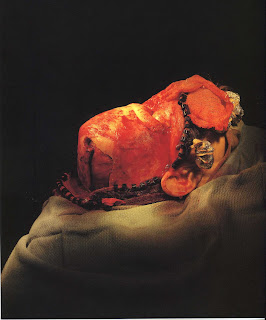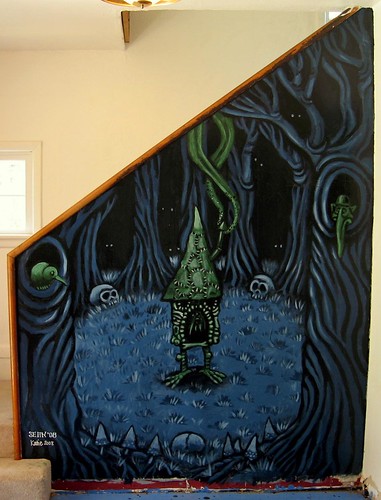Thought I'd review and post a few pics from a favorite art book of mine:
The Sacred Heart: An Atlas of the Body Seen Through Invasive Surgery, a collection of photographs by
Max Aguilera-Hellweg. The book was published in 1997 and now appears to be out-of-print -- and selling for outrageous prices. However, you should be able to find a copy at your library or through
interlibrary loan (which is what I had to do, since some
swine stole my local library's copy).
***
Like most artists I've always been fascinated by the human body -- how it's made and how it works. Aside from natural curiosity, I also sort of assumed it was my
duty to study anatomy if I wanted to really be an artist. I really enjoy reading about the history of medicine, and it's especially interesting to note the shared developments in the sciences and art -- the best example of this is, obviously, the Renaissance. It's inspiring and infuriating to discover the ridiculous troubles and risks da Vinci and others went through to thoroughly and objectively examine cadavers -- an opportunity I imagine medical students take for granted today, but the kind of first-hand knowledge most art students no longer seem interested in procuring, unfortunately. I suppose there are still a few schools that emphasize figurative art and provide students with the chance to observe (or even participate) in dissections, but my art school didn't, and I know no other artists whose schools did.
So I've always kept an eye out (pun intended -- see first pic below) for any books that allow me new or unique glimpses of our body's workings. Most of these texts are pretty basic and will be familiar to any artist: Vesalius' anatomical plates,
Gray's Anatomy, etc. -- most which are only secondarily "artful" (In fact, many of my favorite "art" books were never intended as such: Harold Edgerton's
Stopping Time, Michael Light's
100 Suns, Ernst Haeckel's
Art Forms in Nature. There's something bracing and authentic about the careful, deliberate observation on display in these examples, qualities many artists spend most of their lives trying to emulate only to find they know
too much about seeing and must unlearn what they think they know).
I'm not sure when or how I first discovered Aguilera-Hellweg's work or this book -- I believe he also does journalistic photography, so perhaps I saw his stuff in a magazine? Now that I think about it, I suppose some of the photos in this volume likely appeared in
Nature or
Scientific American or the like. At any rate, it's good work. These pictures night bring to mind other artists' interpretations of medical procedures, such as Rembrandt's "Anatomy Lesson" or Thomas Eakins' "The Gross Clinic" as well as Stan Brakhage's autopsy film "The Act of Seeing With One's Own Eyes".
I do feel an uneasiness about the work here, though. I don't think it's exploitative -- it's tastefully done, formally and techincally lovely (not that those attributes alone exclude a work from opportunism or shock) but I wonder if it's
too pretty or artful. Despite the horror of what we see, and no matter how simply he presents it, there is a glossy, facile, almost "professional" quality to the prints which must in some way comfort all but the most squeamish viewer. I think all of the artists mentioned are in awe of the human body and the doctors' skills (and bravery -- would
you want to open someone's skull?) but Aguilera-Hellweg, Rembrandt and Eakins somehow risk solacing or distracting us with their great skill -- the beautiful compositions and light and careful colors.
Brakhage's film, though, is almost inept its bluntness, and remains the most unpleasant document of its sort that I've seen. Perhaps it's significant that he was filming autopsies rather than restorative surgery; doctors can be noble and heroic -- what of the anonymous, lab-coated morticians? They're almost characters from a horror film. Yet I would never call Brakhage's work exploitative either -- if he's not as admiring or elevating as Aguilera-Hellweg or Rembrandt or Eakins, there is still evident a genuine curiosity or shock or even confusion (is this a human body? what am I seeing?) that is just as valid.
Okay, I've blathered on enough... the photos are below. Please be warned: These might not be to everyone's taste. Apologies if this post troubles anyone.
.jpg)
.jpg)
.jpg)
.jpg)
.jpg)
.jpg)
.jpg)
.jpg)









